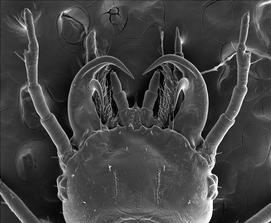A beetle larva that waves its antennae to attract amphibians  before grabbing them, drinking their body juices and reducing them to a dessicated husk has been discovered by scientists in Israel.
before grabbing them, drinking their body juices and reducing them to a dessicated husk has been discovered by scientists in Israel.
Small beetles and larvae make an ideal toad and frog-sized meal, and these amphibians are well-adapted to stealthily creeping up on them and using a lightning-fast flick of the tongue to turn them into lunch.
But in a rare example of role-reversal, predator has become prey. Writing in PLoS One, Tel-Aviv University researchers Gil Wizen and Avital Gasith have discovered that two species of Epomis ground beetle larvae found in the Middle East, E. circumscriptus and E. dejeani, exploit the very same movements that attract frogs and toads in the first place - by waving their antennae around - only to dodge the predators' attempts to eat them and then grab on to the amphibian themselves. The larvae are equipped with razor-sharp mouthparts, which they use to pierce the amphibian's skin and then drink the body fluids. In some cases they even consume the unfortunate victim's flesh.
The researchers began to study the Epomis beetles in 2007 after finding specimens of the larvae attached to amphibians in the wild. But how this status quo was reached - with what should be the hunter being consumed by the hunted - was not known.
To find out, in hundreds of experiments the research duo placed  one or more of the larvae into a tank together with a suitable amphibian study subject and videoed the results. The footage shows the larvae increasing the intensity of their antenna-waving activities as the potential victim approaches. When the amphibian makes a grab, the larva dodges the lunge before parrying with an attack of its own, in some cases grabbing the mouthparts and on other occasions latching on behind the head. With an hour or so the amphibian is dead.
one or more of the larvae into a tank together with a suitable amphibian study subject and videoed the results. The footage shows the larvae increasing the intensity of their antenna-waving activities as the potential victim approaches. When the amphibian makes a grab, the larva dodges the lunge before parrying with an attack of its own, in some cases grabbing the mouthparts and on other occasions latching on behind the head. With an hour or so the amphibian is dead.
The success rate of the strategy is staggering. Out of about 400 face-offs, the amphibians got the larvae into their mouths only 7 times. But even then only transiently: they quickly spat them out, at which point the larvae promptly turned around and made a succesful attack of their own. In one even more surprising experiment, a toad did swallow one of the larvae, which continued to writhe around in the animal's stomach for a further two hours before it was regurgitated. At this point, apparently unharmed, the larva then make a meal of the toad that had previously consumed it.
This kind of role-reversal is extremely rare. In only about 10 percent of predator-prey relationships in the animal kingdom does a smaller animal eat a bigger one, but these are all active attacks rather than a small creature luring its prey. Wizen and Gasith thing that it could have evolved as a means of anti-predator defence, which has subsequently become the creature's exclusive lifestyle. The amphibians may not have evolved to combat the threat since, compared with the majority of the their food, for which their hunting strategy is highly successful, these beetle larvae are relatively rare...










Comments
Add a comment